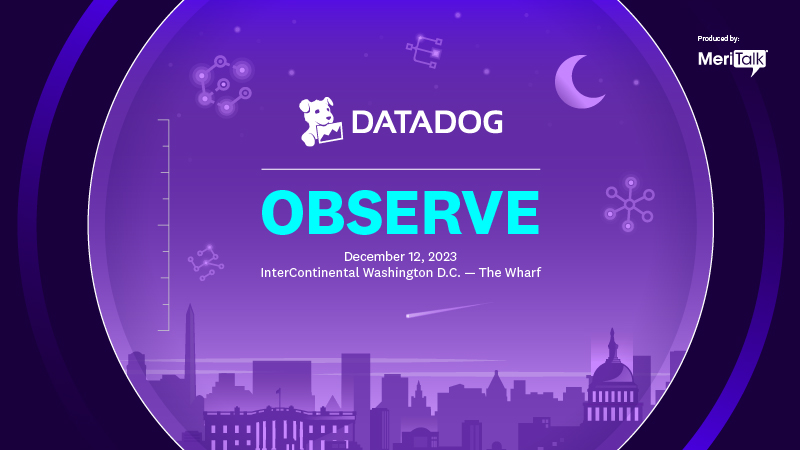
Federal government agencies are running hard to meet challenging White House technology policy mandates on a host of fronts – with cloud adoption, zero trust security migration, and customer experience improvements high on that list.
Come join us on Dec. 12 in Washington, D.C. at the Datadog Observe in-person conference at the InterContinental Hotel at the Wharf to find out how gaining the latest capabilities for technology “observability” has become a vital accelerator for government agencies to speed their progress on those mandates.
Here’s a rundown of what’s in play for government agencies faced with White House orders for large-scale tech improvements, and sure to figure into discussions at the Dec. 12 conference.
Cloud adoption – Federal agencies are being pushed to adopt more cloud services through several big and ongoing policy directives.
Those include the 2019 Cloud Smart strategy that directs government agencies to improve citizen service, modernize their IT technology base, and boost cybersecurity. The cloud adoption wave received another major push through the Biden administration’s 2021 Cybersecurity Executive Order, with further cloud adoption and migration to zero trust security among its two chief mandates.
And late last year, Congress codified into Federal law the General Services Administration’s Federal Risk and Authorization Management Program (FedRAMP). The 11-year-old FedRAMP program provides a standardized, government-wide approach to security assessment, authorization, and continuous monitoring for cloud products and services used by Federal government agencies, and its ongoing revamp as ordered by Congress aims to quicken the pace of approved cloud services that agencies can use.
Notably, Datadog announced this week that it is committed to pursuing FedRAMP High authorization. For Defense Department agencies, this level of authorization corresponds to Impact Level 5 (IL5).
“This means that public-sector organizations that require these higher-level certifications will be able to use Datadog to monitor the health, performance, and security of all of their applications and infrastructure,” the company said in a press release.
Zero trust security – The 2021 Cybersecurity Executive Order’s push for Federal agencies to adopt zero trust security represents the largest shift in the government’s security approach in decades, and its execution is dominating agency security budgets and IT modernization plans.
Case in point: for a security construct that was hardly spoken of outside of security architecture circles just three years ago, the order for zero trust adoption has pushed Federal agency funding requests for zero trust to a total of $12 billion in the Biden administration’s Fiscal Year 2024 budget requests, according to figures offered earlier this year by Federal Chief Information Security Officer Chris DeRusha.
Another major driver of government security improvements is the National Cybersecurity Strategy published in March by the Office of the National Cyber Director, and the follow-up implementation plan released in June. That plan focuses on achieving “cybersecurity regulatory harmonization” across the government and lays out nearly 70 taskings for Federal agencies to help execute the directive.
Customer experience – And last but far from least, the Biden administration’s December 2021 Customer Experience Executive Order is driving Federal agencies to improve the quality of citizen interactions with the government across dozens of areas ranging from accessing retirement benefits to renewing travel passports.
The executive order is providing a major push for one of the pillars of the President’s Management Agenda (PMA) policies that identify customer experience improvements – along with workforce and acquisition issues – as centerpieces of the administration’s technology-focused and enabled policy agenda.
Notably, the executive order and the PMA envision the conversion of the existing USA.gov website into a central “digital Federal front door” for the public to access all government benefits, services, and programs “in just 1 to 3 clicks, taps, or commands from the USA.gov homepage, without navigating duplicate and outdated Federal websites.”
Tech Leaders Speaking – Join us at the Datadog Observe conference on Dec. 12 to get the latest from top executives at Datadog, AWS, ArcheSys, Raytheon, and Systalex along with Federal government tech leaders who are grappling with these tech mandates, and how the advantages of observability across tech stacks are helping those efforts.
The government speaker lineup features:
Bob Amos, Director, Division of Website Operations, at the Centers for Medicare & Medicaid Services;
Taka Ariga, Chief Data Scientist and Director of the Innovation Lab, Science, Technology Assessment, and Analytics, at the Government Accountability Office;
Lauren Boas Hayes, Senior Advisor for Technology and Innovation, at the Cybersecurity and Infrastructure Security Agency;
Melvin Brown II, Deputy Chief Information Officer at the Office of Personnel Management;
Jonathan Feibus, Chief Information Security Officer and Director of the Cyber and Infrastructure Security Division, at the Nuclear Regulatory Commission; and
Jeremy A. Yates, Deputy Technology Architect at Ginnie Mae.
Training Opportunities – In addition to the speaker-led sessions, Datadog Observe will include technical sessions highlighting observability-driven security and monitoring your hybrid cloud infrastructure as well as the “Observability To Unlock Cloud Insights” workshop where you’ll get a hands-on look at the components of a new observability toolbelt, including metrics, dashboards, traces, and logs.
Please register here to reserve your spot at Datadog Observe on Dec. 12 in Washington, D.C.
